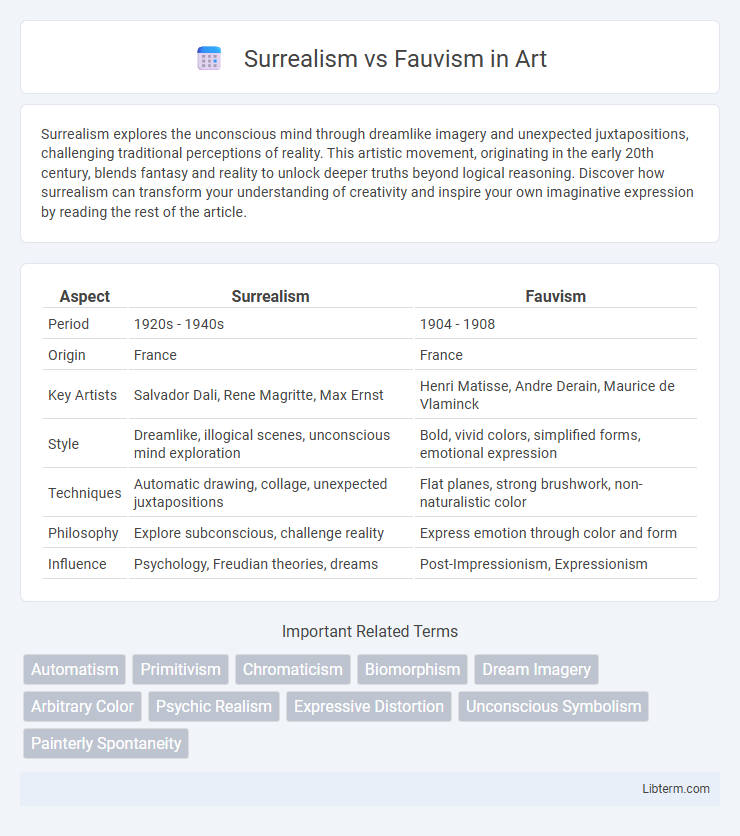Surrealism explores the unconscious mind through dreamlike imagery and unexpected juxtapositions, challenging traditional perceptions of reality. This artistic movement, originating in the early 20th century, blends fantasy and reality to unlock deeper truths beyond logical reasoning. Discover how surrealism can transform your understanding of creativity and inspire your own imaginative expression by reading the rest of the article.
Table of Comparison
| Aspect | Surrealism | Fauvism |
|---|---|---|
| Period | 1920s - 1940s | 1904 - 1908 |
| Origin | France | France |
| Key Artists | Salvador Dali, Rene Magritte, Max Ernst | Henri Matisse, Andre Derain, Maurice de Vlaminck |
| Style | Dreamlike, illogical scenes, unconscious mind exploration | Bold, vivid colors, simplified forms, emotional expression |
| Techniques | Automatic drawing, collage, unexpected juxtapositions | Flat planes, strong brushwork, non-naturalistic color |
| Philosophy | Explore subconscious, challenge reality | Express emotion through color and form |
| Influence | Psychology, Freudian theories, dreams | Post-Impressionism, Expressionism |
Introduction to Surrealism and Fauvism
Surrealism emerged in the early 1920s as an avant-garde movement centered on unlocking the unconscious mind through dreamlike, fantastical imagery and unexpected juxtapositions that challenged traditional artistic norms. Fauvism, originating just before World War I around 1905, emphasized bold, vivid colors and simplified forms to evoke emotional responses rather than realistic depictions. Both movements revolutionized modern art by breaking away from conventional representation, with Surrealism exploring psychological depth and Fauvism focusing on pure color and painterly expression.
Historical Origins and Key Influences
Surrealism emerged in the early 1920s, rooted in the aftermath of World War I and heavily influenced by Sigmund Freud's theories of the unconscious mind and dreams, emphasizing irrationality and the exploration of the subconscious. Fauvism originated earlier, around 1904-1908, primarily in France, characterized by bold, non-naturalistic color use inspired by Post-Impressionists like Vincent van Gogh and Paul Gauguin, with key figures such as Henri Matisse and Andre Derain leading the movement. Both movements reacted against traditional academic art but diverged in focus: Fauvism celebrated vibrant color and spontaneous brushwork, while Surrealism delved into psychological depth and dream-like imagery.
Defining Features of Surrealism
Surrealism is defined by its emphasis on the unconscious mind, dream imagery, and illogical scenes, often employing techniques like automatic writing and exquisite corpse to unlock hidden thoughts. Unlike Fauvism, which prioritizes bold, exaggerated colors and painterly qualities, Surrealism explores complex symbolism and bizarre, fantastical juxtapositions to challenge reality. This movement is deeply rooted in Freudian psychoanalysis, seeking to transcend rationalism and evoke emotional responses through unexpected, often unsettling visual narratives.
Characteristics of Fauvism
Fauvism is characterized by vivid, non-naturalistic colors and bold brushwork that emphasize painterly qualities over realistic representation. Fauvist artists often employed simplified forms and distorted perspectives to evoke emotional responses rather than depict accurate scenes. This movement, led by Henri Matisse and Andre Derain, prioritized color as an independent element of composition, contrasting sharply with the dream-like, subconscious themes explored in Surrealism.
Pioneering Artists in Surrealism
Surrealism, pioneered by artists such as Salvador Dali, Andre Breton, and Max Ernst, emphasizes dreamlike imagery and the exploration of the unconscious mind, contrasting sharply with Fauvism's vibrant color palette and loose brushwork championed by Henri Matisse and Andre Derain. Dali's hyperrealistic techniques and symbolic art forms define Surrealism's focus on irrational and fantastical representations. The movement's innovative approach revolutionized 20th-century art by merging psychological depth with visual expression, diverging from Fauvism's emphasis on pure color and emotional intensity.
Leading Figures in Fauvism
Leading figures in Fauvism include Henri Matisse, known for his bold use of color and simplified forms, and Andre Derain, who emphasized vibrant palettes and dynamic brushwork. Other prominent artists such as Maurice de Vlaminck contributed to the movement's intense chromatic expression and emotional impact. These painters collectively challenged traditional representation, prioritizing vivid, non-naturalistic colors that contrast sharply with Surrealism's focus on dreamlike and subconscious imagery.
Techniques and Color Usage Comparison
Surrealism utilizes dreamlike, illogical scenes with meticulous brushwork to convey subconscious imagery, often blending realistic detail with fantastical elements. Fauvism emphasizes bold, vibrant, and non-naturalistic colors combined with simplified forms and expressive brushstrokes to evoke strong emotional responses. While Surrealist techniques focus on creating an uncanny atmosphere through precise detail, Fauvist artists prioritize color intensity and painterly freedom to capture raw, immediate impressions.
Underlying Philosophies and Artistic Intent
Surrealism emphasizes unlocking the unconscious mind through dreamlike, irrational imagery to explore deeper psychological truths beyond reality. Fauvism prioritizes bold color and painterly freedom to evoke raw emotional responses and break away from traditional representation. Both movements challenge conventional art but diverge philosophically: Surrealism seeks to reveal hidden meanings, while Fauvism celebrates visual intensity and spontaneity.
Surrealism vs Fauvism: Legacy and Impact
Surrealism revolutionized modern art by exploring the unconscious mind through dreamlike, illogical imagery, influencing psychology, literature, and film while inspiring future avant-garde movements. Fauvism, with its bold, vibrant colors and emotional intensity, transformed color usage in painting, laying groundwork for Expressionism and abstract art. Both movements left a lasting legacy by challenging traditional aesthetics and expanding artistic expression beyond realistic representation.
Conclusion: Contrasts and Connections
Surrealism explores the unconscious mind through dream-like imagery and irrational juxtapositions, while Fauvism emphasizes bold colors and simplified forms to evoke emotional intensity. Both movements break away from traditional representation, yet Surrealism delves into psychological depth whereas Fauvism celebrates raw visual expression. Their contrasting approaches highlight diverse paths in modern art, underscoring innovation and emotional impact.
Surrealism Infographic

 libterm.com
libterm.com